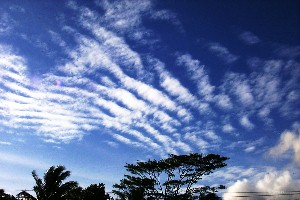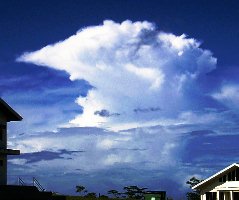Midterm Spring 2000
- What is the numerical value of the Environmental Lapse Rate (ELR) in degrees Celsius per
kilometer of rise in altitude?
- If the temperature at sea level is 30°C, what is the temperature at the tropopause, 16
km up in the atmosphere (use the ELR for this calculation).
- Calculate the albedo for a cloud that receives 25 units of solar energy and reflects 20
units of that solar energy.
- What is the name of the layer of the atmosphere where the top of a cumulonimbus anvil
head cloud stops rising and spreads out?
- What is the name of the layer of the atmosphere in which ozone is found?
- What is the name of the cloud type seen on the right?

- From where does the water come that appears on the outside of a cold can of soda that is
sitting outside on a warm day?
- What is the temperature at which water freezes in Celsius?
- What is the word for "cloud" in your first language?
- What does the word "nimbus" refer to in weather and climate class?
- In terms of energy and the atmosphere, what do carbon dioxide, water vapor, methane, and
ozone all do?
- In our insolation diagram 100 units of sun energy enters the atmosphere. The
atmosphere, however, temporarily stores 160 units of sun energy, 60% more than is put in
by the sun. What is the name for this effect?
- Why does the above effect occur?
- What are the colors of the sun as seen in a rainbow in English?
- What is the word for rainbow in your first language?
- What is the numerical value of the Dry "Air" (Adiabatic) Lapse Rate in degrees
Celsius per kilometer of rise in altitude?
- If an empty glass is chilled in the refridgerator and then taken out of the
refridgerator here on Pohnpei, will water appear on the cold glass?
- A parcel of air at 30°C rises 1 km above the ground, cooling at the Dry Air Lapse Rate.
What is the temperature of the parcel of air at 1 km above the ground?
- The same parcel as in question 4 saturates at that 1 km point above the ground,
producing a cloud, and continues to rise to a height of 3 km above the ground, cooling now
at the Saturated Air Lapse Rate. What is the final temperature of the air parcel at
3 km above the ground?
- What is unique about the updraft in a supercell storm cloud?
- If a cumulonimbus cloud has no supercooled water, can thunder occur?
- Is the bottom of a lightning producing cumulonimbus cloud usually positively or
negatively charged?
- What is the word for lightning in your language?
- What is the word for thunder in your language?
- If you feel your hair prickle and stand up during a lightning storm, what should you do?
- Why don't tropical rain storms produce a lot of lightning and thunder?
- In which direction do tornadoes spin in the Northern hemisphere?
- On the Fujita-Pearson Tornado intensity scale, which is more intense, an F1 or an F5
tornado?
- What is a funnel cloud?
- Which of the following places has the most tornadoes: Texas, Alaska, Hawaii, Pohnpei?
- What is a dust devil?
- If the wind is from the northeast during a tropical storm, in what direction is the
center of the tropical storm?
- If the wind is from the South during a typhoon in Chuuk, is the storm likely to be
coming towards Chuuk or moving away from Chuuk?
- What is the name for the spreading top of the cloud seen at the right?

- Draw a sketch of the airflow patterns inside a cumulonimbus cloud. Be sure to
include the major air flows and the direction of travel of the cumulonimbus cloud.
- Draw a labeled diagram of a cirrus cloud explaining why they have that distinctive comma
shape.
- Extra credit: What is the word for "rolling thunder" in your language (not
thunder, but the travelling thunder we talked about in class)?
Weather course home page
Lee Ling home
COM-FSM home page



